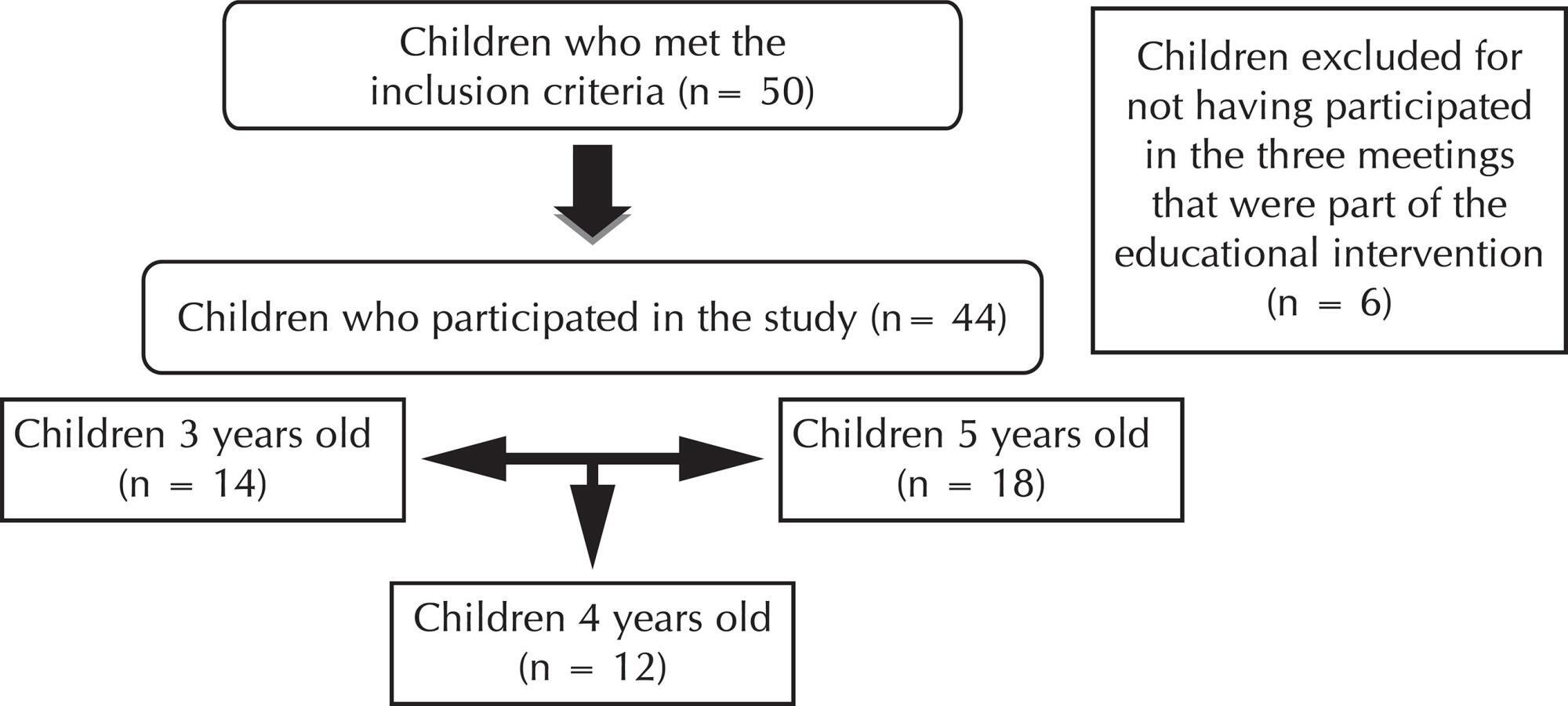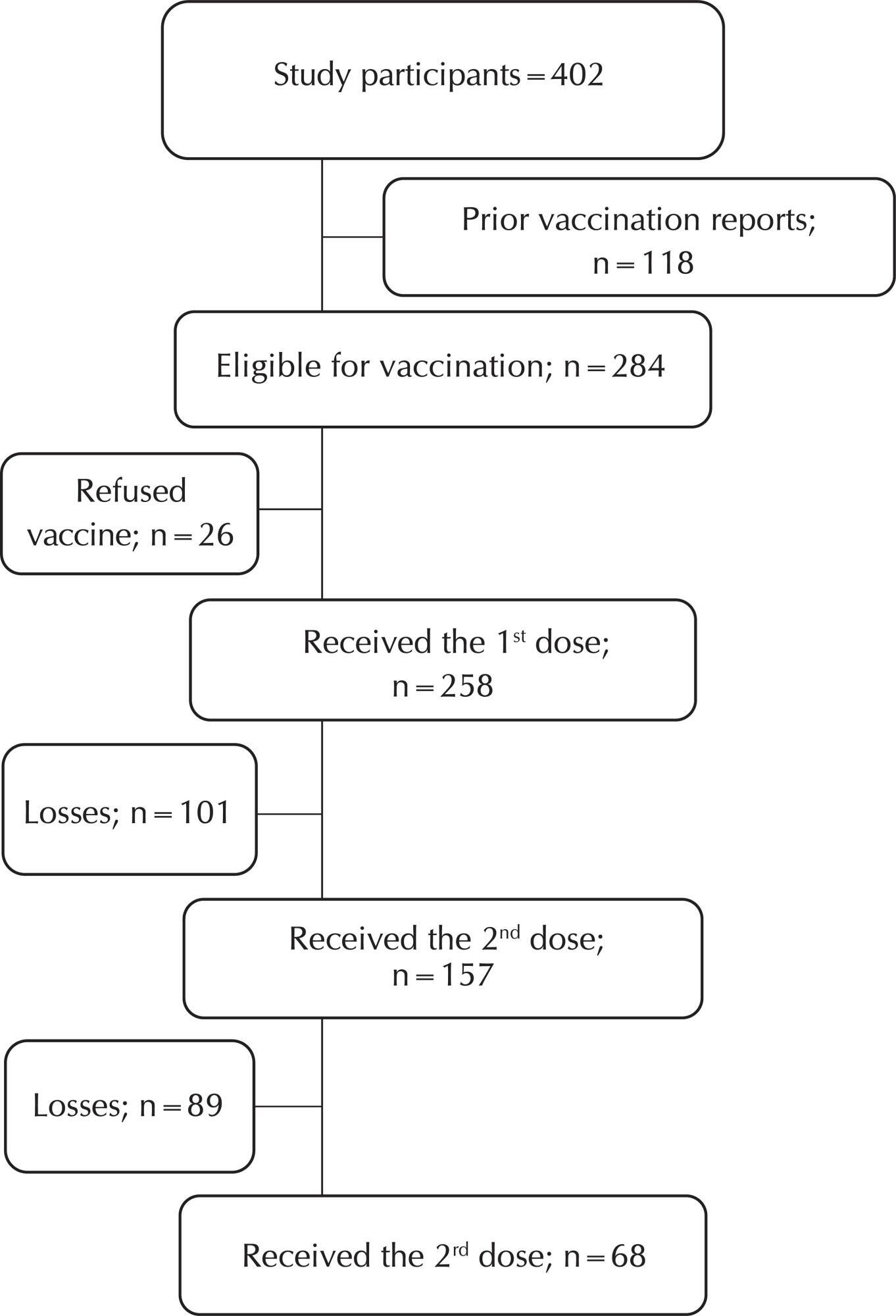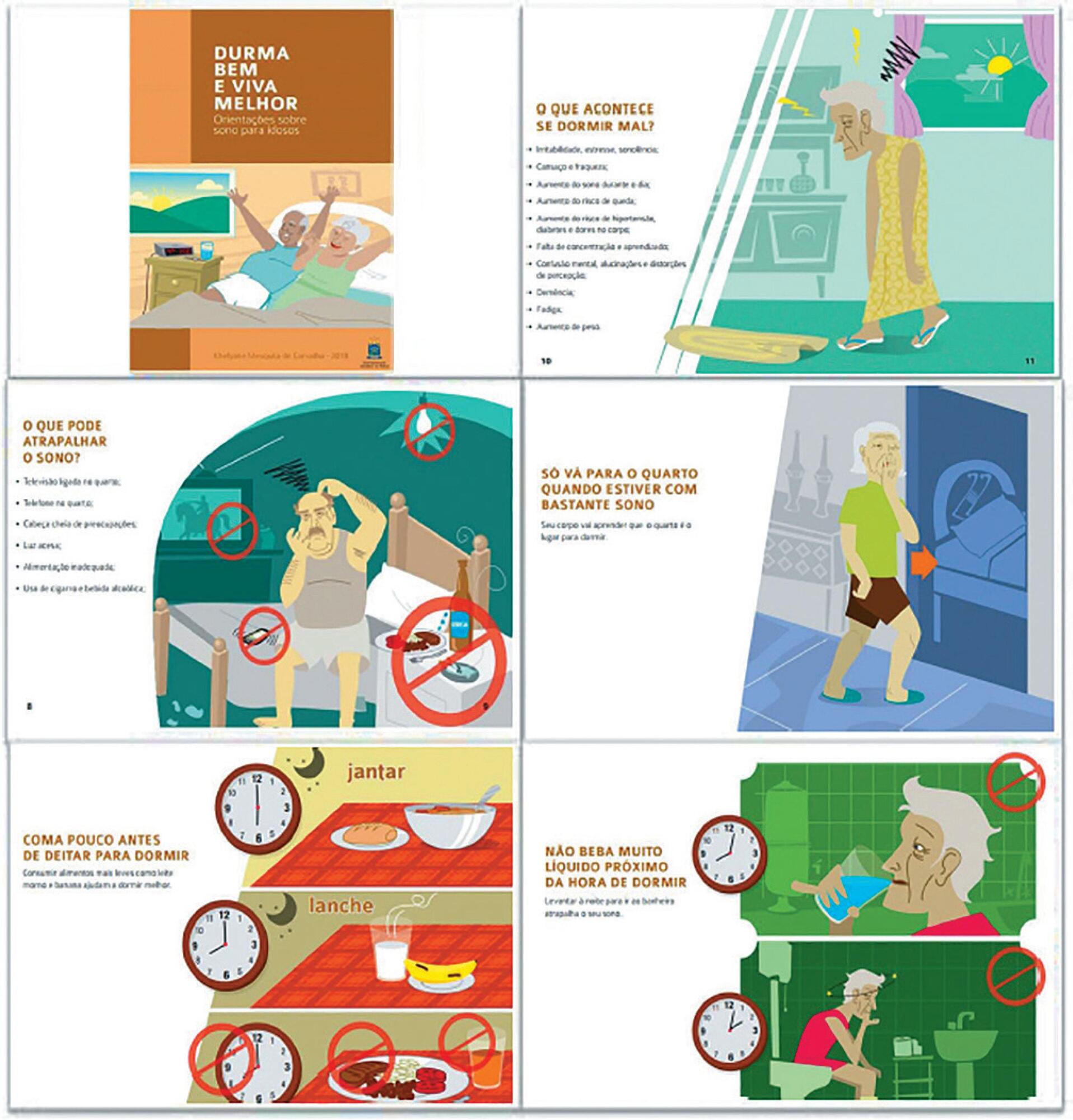-
PESQUISA01/01/2017
Promoting oral care in the preschool child: effects of a playful learning intervention
Revista Brasileira de Enfermagem. 2017;70(3):519-525
Resumen
PESQUISAPromoting oral care in the preschool child: effects of a playful learning intervention
Revista Brasileira de Enfermagem. 2017;70(3):519-525
DOI 10.1590/0034-7167-2016-0237
Visualizações0Ver maisABSTRACT
Objective:
To compare the number of appropriate behaviors for tooth brushing before and after a playful learning intervention with preschool children.
Method:
A quasi-experimental, quantitative, before and after study design was conducted in an early childhood educational institution, with children between three and five years of age. The intervention consisted of three meetings with educational activities about tooth brushing, whose outcome was evaluated by means of observation of ten behaviors suitable for tooth brushing.
Results:
Forty-four children participated in the study. The mean of adequate behaviors was 4.4 before the intervention, and 8.5 after the intervention. A significant increase in the adoption of appropriate behaviors for tooth brushing (p <0.01) was identified.
Conclusion:
Nurses can enhance oral health promotion actions with preschoolers in preschool institution using playful learning interventions

-
PESQUISA01/01/2017
Violence against children and adolescents: the perspective of Primary Health Care
Revista Brasileira de Enfermagem. 2017;70(3):511-518
Resumen
PESQUISAViolence against children and adolescents: the perspective of Primary Health Care
Revista Brasileira de Enfermagem. 2017;70(3):511-518
DOI 10.1590/0034-7167-2016-0471
Visualizações0Ver maisABSTRACT
Objective:
To analyze the care provided by Basic Health Units (BHU) to families involved in domestic intrafamily violence against children and adolescents.
Method:
Qualitative research, based on the Paradigm of Complexity. Data collection was performed with 41 professionals through focus groups and semi-structured interviews.
Results:
The following categories emerged from data analysis: ‘Everything comes here’, which reflects the legitimate place of BHUs for the population and the actions taken to build care for families; and ‘We only do what is really necessary’, which brings the look to violence still based on the positivist and biomedical paradigm.
Final considerations:
The model of understanding and construction of work processes in the BHU is structured in the aforementioned paradigm. Nurses have the possibility to become agents of change, both in professionals’ training and in the care thought and provided to communities.
-
PESQUISA01/01/2017
Integrality of care: challenges for the nurse practice
Revista Brasileira de Enfermagem. 2017;70(3):504-510
Resumen
PESQUISAIntegrality of care: challenges for the nurse practice
Revista Brasileira de Enfermagem. 2017;70(3):504-510
DOI 10.1590/0034-7167-2016-0380
Visualizações0Ver maisABSTRACT
Objective:
to understand the role of the nurse in the collegiate management model of a teaching hospital, in the integrality of care perspective.
Method:
a single case study with multiple units of analysis, with the theoretical proposition «integrality of care is a result of the care offered to the user by multiple professionals, including the nurse». Data were obtained in a functional unit of a teaching hospital through interviews with 13 nurses in a non-participant observation and document analysis.
Results:
from the analytical categories emerged subcategories that allowed understanding that the nurse promotes integrality of care through nursing management, team work and integration of services.
Final considerations:
the theoretical proposition was confirmed and it was verified that the nursing management focus on attending to health care needs and is a strategy to provide integrality of care.
-
PESQUISA01/01/2017
Low completion rate of hepatitis B vaccination in female sex workers
Revista Brasileira de Enfermagem. 2017;70(3):489-494
Resumen
PESQUISALow completion rate of hepatitis B vaccination in female sex workers
Revista Brasileira de Enfermagem. 2017;70(3):489-494
DOI 10.1590/0034-7167-2016-0567
Visualizações0Ver maisABSTRACT
Objective:
to assess predictive factors for noncompletion of the hepatitis B vaccination schedule in female sex workers in the city of Teresina, Northeastern Brazil.
Method:
402 women were interviewed and, for those who did not wish to visit specialized sites, or did not know their hepatitis B vaccination status, the vaccine was offered at their workplaces. Bi- and multivariate analyses were performed to identify potential predictors for noncompletion of the vaccination schedule.
Results:
of the 284 women eligible for vaccination, 258 (90.8%) received the second dose, 157/258 (60.8%) and 68/258 (26.3%) received the second and third doses, respectively. Working at clubs and consuming illicit drugs were predictors for noncompletion of the vaccination schedule.
Conclusion:
the high acceptability of the vaccine’s first dose, associated with low completion rates of the vaccination schedule in sex workers, shows the need for more persuasive strategies that go beyond offering the vaccine at their workplaces.

-
PESQUISA01/01/2017
Cost of nursing most frequent procedures performed on severely burned patients
Revista Brasileira de Enfermagem. 2017;70(3):481-488
Resumen
PESQUISACost of nursing most frequent procedures performed on severely burned patients
Revista Brasileira de Enfermagem. 2017;70(3):481-488
DOI 10.1590/0034-7167-2015-0034
Visualizações0Ver maisABSTRACT
Objective:
to identify the mean direct cost (MDC) of the most frequent procedures performed by nursing professionals on severely burned patients in an Intensive Care Unit.
Method:
exploratory-descriptive quantitative single-case study. The MDC was calculated by multiplying time (timed) spent by nursing professionals in the performance of the procedures by the unit cost of direct labor, and adding the costs of material and medicine/solutions.
Results:
a MDC of US$ 0.65 (SD=0.36) was obtained for «vital signs monitoring»; US$ 10.00 (SD=24.23) for «intravenous drug administration»; US$ 5.90 (SD=2.75) for «measurement of diuresis»; US$ 0.93 (SD=0.42) for «capillary blood glucose monitoring»; and US$ 99.75 (SD=129.55) for «bandaging».
Conclusion:
the knowledge developed can support managerial decision-making, contribute to the efficiency distribution of the resources involved and, when possible, provide cost-containment or cost-minimization strategies without impairing the quality of nursing care.
-
PESQUISA01/01/2017
Nursing Activities Score and Acute Kidney Injury
Revista Brasileira de Enfermagem. 2017;70(3):475-480
Resumen
PESQUISANursing Activities Score and Acute Kidney Injury
Revista Brasileira de Enfermagem. 2017;70(3):475-480
DOI 10.1590/0034-7167-2016-0266
Visualizações0Ver maisABSTRACT
Objective:
to evaluate the nursing workload in intensive care patients with acute kidney injury (AKI).
Method:
A quantitative study, conducted in an intensive care unit, from April to August of 2015. The Nursing Activities Score (NAS) and Kidney Disease Improving Global Outcomes (KDIGO) were used to measure nursing workload and to classify the stage of AKI, respectively.
Results:
A total of 190 patients were included. Patients who developed AKI (44.2%) had higher NAS when compared to those without AKI (43.7% vs 40.7%), p <0.001. Patients with stage 1, 2 and 3 AKI showed higher NAS than those without AKI. A relationship was identified between stage 2 and 3 with those without AKI (p = 0.002 and p <0.001).
Conclusion:
The NAS was associated with the presence of AKI, the score increased with the progression of the stages, and it was associated with AKI, stage 2 and 3.
-
PESQUISA01/01/2017
Nursing appointment and cardiometabolic control of diabetics: a randomized clinical trial
Revista Brasileira de Enfermagem. 2017;70(3):468-474
Resumen
PESQUISANursing appointment and cardiometabolic control of diabetics: a randomized clinical trial
Revista Brasileira de Enfermagem. 2017;70(3):468-474
DOI 10.1590/0034-7167-2016-0352
Visualizações0Ver maisABSTRACT
Objective:
to verify the effect of nursing appointment on cardiometabolic profile of people with Diabetes Mellitus type 2.
Method:
randomized controlled trial, developed with 134 individuals chosen for two groups: intervention and control. The intervention consisted of three nursing appointments alternated bimonthly, with two phone calls, over five months. The control group received usual care offered by the Health Unit. Data were collected through semi-structured interviews before and after the intervention, in addition to conducting laboratory tests.
Results:
after the intervention, a significant difference was shown in the amount of glycated hemoglobin (p = 0.006) and in the systolic blood pressure (p = 0.031), which were higher in the control group.
Conclusion:
besides being low-cost and easy to develop on the monitoring routine of people with diabetes, the intervention performed influenced positively the biochemical profile.
-
PESQUISA01/01/2017
Terms of the specialized nursing language for the care of ostomates
Revista Brasileira de Enfermagem. 2017;70(3):461-467
Resumen
PESQUISATerms of the specialized nursing language for the care of ostomates
Revista Brasileira de Enfermagem. 2017;70(3):461-467
DOI 10.1590/0034-7167-2015-0058
Visualizações0Ver maisABSTRACT
Objectives:
to identify terms of the specialized nursing language for the care of ostomates from the literature of the area, and to map the identified terms with terms of the International Classification for Nursing Practice (ICNP®).
Method:
descriptive study of quantitative approach guided by the guidelines for the elaboration of terminology subsets of the ICNP®. The terms were collected in 49 scientific articles, extracted using a computational tool, selected according to the relevance for the theme, and normalized and mapped with the ICNP®.
Results:
20,668 terms were extracted. The standardization process resulted in 425 relevant terms (151 were constant in ICNP® and 274 were not contained in ICNP®), of which 154 were similar, 19 were more comprehensive, 50 were more restricted, and 51 were not in concordance.
Conclusion:
the use of standardized language can minimize the ambiguities and redundancies identified in the mapping. The existence of terms not in concordance with the ICNP® reinforces the need for constant updating of this classification.
-
ARTÍCULO ORIGINAL05/12/2019
Spirituality and religiosity for the transcendence of the elderly being
Revista Brasileira de Enfermagem. 2019;72:259-265
Resumen
ARTÍCULO ORIGINALSpirituality and religiosity for the transcendence of the elderly being
Revista Brasileira de Enfermagem. 2019;72:259-265
DOI 10.1590/0034-7167-2018-0840
Visualizações0Ver maisABSTRACT
Objective:
to understand the life experiences that favor transcendence of the elderly being.
Method:
a qualitative phenomenological hermeneutic study, in two groups of elderly coexistence. The selection of participants was by intentional sampling: 11 elderly, achieving theoretical saturation. Data collection was carried out through a phenomenological interview with a detonating question. Ethical principles of the General Health Law in health research were fulfilled. Analysis with Heideggerian hermeneutic circle was performed.
Results:
unity of meaning on the consciousness of a higher power for transcendence is highlighted, where spirituality and religiosity are resources of the elderly for strength, feel protected, overcome difficult situations and reach fullness; both favor the understanding of their historicity by manifesting enlightenment.
Final considerations:
transcendence of the elderly being is favored with spirituality and the experiences of their daily life are imbued with a spiritual and religious relationship that give meaning to their existence.
-
ARTÍCULO ORIGINAL18/05/2020
Construção e validação de vídeo educacional para vacinação contra o papilomavírus humano
Revista Brasileira de Enfermagem. 2020;73(4):e20180900
Resumen
ARTÍCULO ORIGINALConstrução e validação de vídeo educacional para vacinação contra o papilomavírus humano
Revista Brasileira de Enfermagem. 2020;73(4):e20180900
DOI 10.1590/0034-7167-2018-0900
Visualizações0Ver maisRESUMO
Objetivos:
validar um vídeo educacional direcionado à adesão da vacinação contra o papilomavírus humano.
Métodos:
estudo metodológico, em que se identificou o conhecimento sobre a temática e a tecnologia a ser construída em seis grupos focais; organizou-se um referencial teórico e levantou-se os vídeos existentes. Após, seguiram-se os estágios de pré-produção, produção e pós-produção. Na validação de conteúdo, participaram 22 especialistas e, na de aparência, dez adolescentes, dez mães, dez professores e dez profissionais da área de audiovisuais. Calculou-se frequência absoluta, Teste Binomial e Content Validity Index.
Resultados:
a concordância foi satisfatória na maioria dos itens. Quanto à relevância, 20 itens tiveram índices acima de 0,80 entre os juízes. A avaliação foi positiva entre meninas e mães. Apenas três itens apresentaram índices menores que 0,80 entre os professores e profissionais de vídeo.
Conclusões:
o vídeo educacional foi validado, conferindo credibilidade para contribuir nas ações educativas e melhorar os índices vacinais.

-
ARTÍCULO ORIGINAL05/12/2019
Construção e validação de cartilha para idoso acerca da higiene do sono
Revista Brasileira de Enfermagem. 2019;72:214-220
Resumen
ARTÍCULO ORIGINALConstrução e validação de cartilha para idoso acerca da higiene do sono
Revista Brasileira de Enfermagem. 2019;72:214-220
DOI 10.1590/0034-7167-2018-0603
Visualizações0Ver maisRESUMO
Objetivo:
construir e validar cartilha educativa para idosos, com orientações sobre higiene do sono.
Método:
pesquisa metodológica com construção da cartilha, validação por 22 juízes e avaliação por 22 idosos. O conteúdo foi extraído das orientações da associação brasileira do sono e do manual de saúde do idoso da Secretaria de Direitos Humanos. Foi considerado válido o item com Índice de Validade de Conteúdo (IVC) maior que 0,8 ou cuja proporção de concordância, verificada com o teste binomial, foi estatisticamente igual ou superior a 80%.
Resultados:
a cartilha apresentou 14 orientações para idosos sobre higiene do sono, distribuídas em 25 páginas. Todos os itens foram avaliados como pertinentes e o IVC teve média de 0,95 pelos juízes e 0,95 pelos idosos.
Conclusão:
a cartilha foi construída e validada quanto seu conteúdo e aparência e pode ser utilizada pelos profissionais de saúde nos diversos serviços com o público idoso.

-
ARTÍCULO ORIGINAL25/11/2020
Vivências familiares na descoberta do Transtorno do Espectro Autista: implicações para a enfermagem familiar
Revista Brasileira de Enfermagem. 2020;73:e20190489
Resumen
ARTÍCULO ORIGINALVivências familiares na descoberta do Transtorno do Espectro Autista: implicações para a enfermagem familiar
Revista Brasileira de Enfermagem. 2020;73:e20190489
DOI 10.1590/0034-7167-2019-0489
Visualizações0Ver maisRESUMO
Objetivos:
descrever a vivência da família no processo de descoberta do diagnóstico e início do tratamento de crianças com Transtorno do Espectro Autista.
Métodos:
estudo qualitativo, descritivo, que entrevistou nove familiares de oito crianças no espectro do autismo, inseridos nos serviços de saúde, educação pública e Associação de Pais e Amigos dos Excepcionais de municípios do interior da região centro-oeste. A coleta de dados foi realizada por entrevistas abertas, nos meses de julho a setembro de 2017. Os dados foram submetidos à análise temática.
Resultados:
no início, houve dificuldade da família na percepção dos primeiros sinais atípicos apresentados pelas crianças. As famílias vivenciam situações de vulnerabilidade, visto que redes de apoio são insuficientes. A escola teve papel significativo no reconhecimento de comportamentos inesperados.
Considerações Finais:
ressalta-se a importância do suporte à família e crianças nessa trajetória oferecido por enfermeiros, profissionais de saúde, escola e dispositivos de suporte social.
-
ARTÍCULO ORIGINAL21/09/2020
Clinical judgment and diagnostic reasoning of nursing students in clinical simulation
Revista Brasileira de Enfermagem. 2020;73(6):e20180878
Resumen
ARTÍCULO ORIGINALClinical judgment and diagnostic reasoning of nursing students in clinical simulation
Revista Brasileira de Enfermagem. 2020;73(6):e20180878
DOI 10.1590/0034-7167-2018-0878
Visualizações0Ver maisABSTRACT
Objectives:
to determine the degree of association between clinical judgment and diagnostic reasoning of nursing students in clinical simulation.
Methods:
this is a correlational research design using a quantitative approach. The sample consisted of 41 nursing students who assisted a patient with vaso-occlusive crisis in a high-fidelity clinical simulation setting. The instruments used included the Lasater Clinical Judgment Rubric – Brazilian Version and the Diagnostic Thinking Inventory.
Results:
clinical judgment was associated with diagnostic reasoning (r=0.313; p=0.046), as well as the “noticing” aspect of clinical judgment with diagnostic reasoning (r=0.312; p=0.047).
Conclusions:
the results show that skills to interpret patient data are associated with diagnostic reasoning skills. Teaching clinical judgment skills is necessary to develop the diagnostic reasoning of nursing students.
-
ARTÍCULO ORIGINAL05/10/2020
Fatores associados à realização de episiotomia
Revista Brasileira de Enfermagem. 2020;73:e20190899
Resumen
ARTÍCULO ORIGINALFatores associados à realização de episiotomia
Revista Brasileira de Enfermagem. 2020;73:e20190899
DOI 10.1590/0034-7167-2019-0899
Visualizações1Ver maisRESUMO
Objetivo:
Avaliar os fatores associados à realização de episiotomia.
Métodos:
Estudo transversal, desenvolvido com dados da pesquisa “Nascer em Belo Horizonte: Inquérito sobre o parto e nascimento”, realizada com 577 mulheres que tiveram seus filhos por via vaginal. Para verificar a magnitude da associação entre a realização de episiotomia e seus possíveis determinantes, foram construídos modelos de regressão logística para estimar a odds ratio.
Resultados:
A episiotomia foi realizada em 26,34% das mulheres; e, destas, 59,21% sabiam que haviam sido submetidas a ela. Observou-se que mulheres mais jovens, primigestas, mulheres assistidas por profissional que não o enfermeiro obstetra e mulheres que tiveram seus bebês em hospital privado apresentam aumento na chance de serem submetidas a esse procedimento.
Conclusão:
Considerando as taxas do uso da episiotomia, este estudo destaca a necessidade de contraindicação absoluta de sua realização indiscriminada.
-
ARTÍCULO ORIGINAL10/02/2020
Perfil de saúde mental de idosos comunitários: um estudo transversal
Revista Brasileira de Enfermagem. 2020;73(1):e20180191
Resumen
ARTÍCULO ORIGINALPerfil de saúde mental de idosos comunitários: um estudo transversal
Revista Brasileira de Enfermagem. 2020;73(1):e20180191
DOI 10.1590/0034-7167-2018-0191
Visualizações0Ver maisRESUMO
Objetivo:
descrever o perfil de saúde mental do idoso cadastrado em uma Unidade de Saúde da Família do município do Recife-PE.
Método:
tratou-se de um estudo quantitativo descritivo, realizado com 159 idosos mediante as escalas Depressão Geriátrica, Resiliência, Apoio Social, Satisfação com a Vida e Afetos Positivos e Negativos, Mini Exame do Estado Mental, Inventário de Eventos Estressantes e Brazil Old Age Shedule.
Resultados:
predominou o sexo feminino, idosos jovens e alfabetizados. A maioria apresenta-se satisfeita com a vida, 52,2% sem sintomas depressivos, 68,6% sem déficit cognitivo, 67,9% alta resiliência e 95,8% alto apoio social, porém 62% de idosos com sintomas depressivos apresentaram déficit cognitivo. Foi identificada correlação negativa entre a presença de depressão e déficit cognitivo, resiliência, apoio social e satisfação com a vida.
Conclusão:
a avaliação destes indicadores permite identificar desencadeadores de sofrimento psíquico, auxiliando a equipe de enfermagem no desenvolvimento de ações preventivas e de cuidado.
-
ARTÍCULO ORIGINAL18/10/2022
Quality of life of nurse practitioners during the COVID-19 pandemic
Revista Brasileira de Enfermagem. 2022;75:e20201382
Resumen
ARTÍCULO ORIGINALQuality of life of nurse practitioners during the COVID-19 pandemic
Revista Brasileira de Enfermagem. 2022;75:e20201382
DOI 10.1590/0034-7167-2020-1382
Visualizações0Ver maisABSTRACT
Objective:
to assess the quality of life of nurse practitioners during the COVID-19 pandemic and analyze related factors.
Methods:
cross-sectional and analytical study carried out with nurse practitioners. A questionnaire on sociodemographic characterization, work activities and changes perceived with the pandemic and WHOQOL-bref were used. To compare the groups of interest, analysis of covariance was used.
Results:
572 professionals participated, who had a mean total quality of life score of 56.79 (SD=13.56). In the relationship of variables with WHOQOL-bref, having two or more jobs and being a nurse were associated with better quality of life, but being a woman and working more than 50 hours a week was associated with a worse perception of the construct.
Conclusions:
the factors analyzed indicate a lower perception of quality of life associated with the social domain, requiring interventions that reduce the damage to professionals’ health and contribute to quality of care provided.
Búsqueda
Buscar en:
Nuvem de Tags
Adolescente (85) Atenção Primária à Saúde (239) COVID-19 (91) Criança (91) Cuidados de Enfermagem (269) Educação em Enfermagem (151) Educação em Saúde (139) Enfermagem (930) Enfermagem Pediátrica (86) Estudantes de Enfermagem (77) Estudos de Validação (131) Família (87) Idoso (208) Promoção da Saúde (99) Qualidade de Vida (104) Saúde do Trabalhador (86) Saúde Mental (145) Saúde Pública (82) Segurança do Paciente (150) Tecnologia Educacional (100)



